Quantifying the Impact of Vegetation Greening on Evapotranspiration and Its Components on the Tibetan Plateau
Abstract
1. Introduction
2. Materials and Methods
2.1. Overview of the Study Area
2.2. Data Sources
2.3. Research Methods
2.3.1. Evaluation of ET
2.3.2. Metrics for Verifying PT-JPL Model Outcomes
2.3.3. Control Design of Vegetation Restoration in ET Assessment
2.3.4. Attribution Analysis
3. Results
3.1. Double Verification of the Model
3.1.1. Validation of Flux Site Data
3.1.2. Validation of GLEAM ET
3.2. Spatiotemporal Dynamics of Vegetation Evolution
3.3. Simulation Results of ET and Its Components in Two Scenarios
3.4. Net Effect of Vegetation Changes on ET and Its Components
3.5. Spatiotemporal Trends of Climatic Drivers and Their Influence on ET
4. Discussion
4.1. Evaluation of ET and Its Components Based on PT-JPL Simulations and Spatiotemporal Patterns
4.2. Effects of Vegetation Dynamics and Climatic Drivers on ET and Its Component Processes
4.3. Ecological Insights and Strategic Recommendations for Vegetation Recovery and Water Management
4.4. Uncertainties and Limitations
5. Conclusions
- (1)
- Model Performance and Vegetation-Induced Effects: The PT-JPL model successfully captured spatial and temporal variations in ET over the TP under vegetation change conditions. The estimated linear trends of ET, ETc, ETi, and ETs were 0.06, 0.39, 0.005, and 0.07 mm/year, respectively. Vegetation greening notably intensified ET, resulting in an annual ET increase of 2.9% compared to the scenario without vegetation change (258.6 ± 120.9 mm vs. 251.2 ± 157.2 mm), thereby indicating greater evaporative water consumption associated with enhanced vegetation cover.
- (2)
- Climate Factors and Dominant Influences: Temperature (TMP) and vapor pressure deficit (VPD) were the primary climatic factors influencing ET and its components. The average contributions of PRE, TMP, RAD, and VPD to ET changes were 0.48, −0.13, 0.04, and −0.05 mm/year, respectively. TMP was the dominant factor affecting ET changes in 53.5% of the TP area, while VPD dominated in 23.0%, PRE in 18.0%, and RAD in 5.5%.
- (3)
- Implications for Water Resource Management: The results underscore the considerable influence of vegetation greening and climatic shifts on ET in the TP. These findings offer actionable guidance for sustainable vegetation restoration and regional water management. Priority should be given to adaptive measures such as improving irrigation efficiency, expanding water storage infrastructure, and promoting policy frameworks for water conservation.
Author Contributions
Funding
Data Availability Statement
Acknowledgments
Conflicts of Interest
References
- Suliman, M.; Scaini, A.; Manzoni, S.; Vico, G. Soil properties modulate actual evapotranspiration and precipitation impacts on crop yields in the USA. Sci. Total Environ. 2024, 949, 175172. [Google Scholar] [CrossRef] [PubMed]
- García, A.G.; Di Bella, C.M.; Houspanossian, J.; Magliano, P.N.; Jobbágy, E.G.; Posse, G.; Fernández, R.J.; Nosetto, M.D. Patterns and controls of carbon dioxide and water vapor fluxes in a dry forest of central Argentina. Agric. For. Meteorol. 2017, 247, 520–532. [Google Scholar] [CrossRef]
- Zeng, Z.; Peng, L.; Piao, S. Response of terrestrial evapotranspiration to Earth’s greening. Curr. Opin. Environ. Sustain. 2018, 33, 9–25. [Google Scholar] [CrossRef]
- Fisher, J.B.; Melton, F.; Middleton, E.; Hain, C.; Anderson, M.; Allen, R.; McCabe, M.F.; Hook, S.; Baldocchi, D.; Townsend, P.A.; et al. The future of evapotranspiration: Global requirements for ecosystem functioning, carbon and climate feedbacks, agricultural management, and water resources. Water Resour. Res. 2017, 53, 2618–2626. [Google Scholar] [CrossRef]
- Walker, G.R.; Hughes, M.W.; Allison, G.B.; Barnes, C.J. The movement of isotopes of water during evaporation from a bare soil surface. J. Hydrol. 1988, 97, 181–197. [Google Scholar] [CrossRef]
- Lan, X.; Liu, Z.; Chen, X.; Lin, K.; Cheng, L. Trade-off between carbon sequestration and water loss for vegetation greening in China. Agric. Ecosyst. Environ. 2021, 319, 107522. [Google Scholar] [CrossRef]
- Schlesinger, W.H.; Jasechko, S. Transpiration in the global water cycle. Agric. For. Meteorol. 2014, 189–190, 115–117. [Google Scholar] [CrossRef]
- Wei, Z.; Yoshimura, K.; Wang, L.; Miralles, D.G.; Jasechko, S.; Lee, X. Revisiting the contribution of transpiration to global terrestrial evapotranspiration. Geophys. Res. Lett. 2017, 44, 2792–2801. [Google Scholar] [CrossRef]
- Xu, S.; Yu, Z.; Yang, C.; Ji, X.; Zhang, K. Trends in evapotranspiration and their responses to climate change and vegetation greening over the upper reaches of the Yellow River Basin. Agric. For. Meteorol. 2018, 263, 118–129. [Google Scholar] [CrossRef]
- Marimon-Junior, B.H.; Hay, J.D.V.; Oliveras, I.; Jancoski, H.; Umetsu, R.K.; Feldpausch, T.R.; Galbraith, D.R.; Gloor, E.U.; Phillips, O.L.; Marimon, B.S. Soil water-holding capacity and monodominance in Southern Amazon tropical forests. Plant Soil 2020, 450, 65–79. [Google Scholar] [CrossRef]
- Cui, Y.; Jia, L. Estimation of evapotranspiration of “soil-vegetation” system with a scheme combining a dual-source model and satellite data assimilation. J. Hydrol. 2021, 603, 127145. [Google Scholar] [CrossRef]
- Xue, Y.; Liang, H.; Zhang, H.; Yin, L.; Feng, X. Quantifying the policy-driven large scale vegetation restoration effects on evapotranspiration over drylands in China. J. Environ. Manag. 2023, 345, 118723. [Google Scholar] [CrossRef] [PubMed]
- Yang, Z.; Bai, P.; Li, Y. Quantifying the effect of vegetation greening on evapotranspiration and its components on the Loess Plateau. J. Hydrol. 2022, 613, 128446. [Google Scholar] [CrossRef]
- Zhou, H.; Ma, L.; Niu, X.; Xiang, Y.; Chen, J.; Su, Y.; Li, J.; Lu, S.; Chen, C.; Wu, Q. A novel hybrid model combined with ensemble embedded feature selection method for estimating reference evapotranspiration in the North China Plain. Agric. Water Manag. 2024, 296, 108807. [Google Scholar] [CrossRef]
- Yu, L.; Liu, Y.; Liu, T.; Yan, F. Impact of recent vegetation greening on temperature and precipitation over China. Agric. For. Meteorol. 2020, 295, 108197. [Google Scholar] [CrossRef]
- Yang, Y.; Roderick, M.L.; Guo, H.; Miralles, D.G.; Zhang, L.; Fatichi, S.; Luo, X.; Zhang, Y.; McVicar, T.R.; Tu, Z.; et al. Evapotranspiration on a greening Earth. Nat. Rev. Earth Environ. 2023, 4, 626–641. [Google Scholar] [CrossRef]
- Łopucki, R.; Klich, D.; Kociuba, P. Detection of spatial avoidance between sousliks and moles by combining field observations, remote sensing and deep learning techniques. Sci. Rep. 2022, 12, 8264. [Google Scholar] [CrossRef]
- Holland, S.; Heitman, J.L.; Howard, A.; Sauer, T.J.; Giese, W.; Ben-Gal, A.; Agam, N.; Kool, D.; Havlin, J. Micro-Bowen ratio system for measuring evapotranspiration in a vineyard interrow. Agric. For. Meteorol. 2013, 177, 93–100. [Google Scholar] [CrossRef]
- Ghisi, T.; Fischer, M.; Nieto, H.; Kowalska, N.; Jocher, G.; Homolová, L.; Burchard-Levine, V.; Žalud, Z.; Trnka, M. Evaluation of the METRIC and TSEB remote sensing evapotranspiration models in the floodplain area of the Thaya and Morava Rivers. J. Hydrol. Reg. Stud. 2024, 53, 101785. [Google Scholar] [CrossRef]
- Mondal, I.; Thakur, S.; De, A.; De, T.K. Application of the METRIC model for mapping evapotranspiration over the Sundarban Biosphere Reserve, India. Ecol. Indic. 2022, 136, 108553. [Google Scholar] [CrossRef]
- Bečanová, J.; Komprdová, K.; Vrana, B.; Klánová, J. Annual dynamics of perfluorinated compounds in sediment: A case study in the Morava River in Zlín district, Czech Republic. Chemosphere 2016, 151, 225–233. [Google Scholar] [CrossRef] [PubMed]
- O’Donncha, F.; Hu, Y.; Palmes, P.; Burke, M.; Filgueira, R.; Grant, J. A spatio-temporal LSTM model to forecast across multiple temporal and spatial scales. Ecol. Inform. 2022, 69, 101687. [Google Scholar] [CrossRef]
- Fisher, J.B.; Tu, K.P.; Baldocchi, D.D. Global estimates of the land–atmosphere water flux based on monthly AVHRR and ISLSCP-II data, validated at 16 FLUXNET sites. Remote Sens. Environ. 2008, 112, 901–919. [Google Scholar] [CrossRef]
- Elfarkh, J.; Johansen, K.; El Hajj, M.M.; Almashharawi, S.K.; McCabe, M.F. Evapotranspiration, gross primary productivity and water use efficiency over a high-density olive orchard using ground and satellite based data. Agric. Water Manag. 2023, 287, 108423. [Google Scholar] [CrossRef]
- Li, X.; Zou, L.; Xia, J.; Zhang, L.; Wang, F.; Li, M. Response of blue-green water to climate and vegetation changes in the water source region of China’s South-North water Diversion Project. J. Hydrol. 2024, 634, 131061. [Google Scholar] [CrossRef]
- Jiang, X.; Wang, Y.; Yinglan, A.; Wang, G.; Zhang, X.; Ma, G.; Duan, L.; Liu, K. Optimizing actual evapotranspiration simulation to identify evapotranspiration partitioning variations: A fusion of physical processes and machine learning techniques. Agric. Water Manag. 2024, 295, 108755. [Google Scholar] [CrossRef]
- Kimball, B.A.; Thorp, K.R.; Boote, K.J.; Stockle, C.; Suyker, A.E.; Evett, S.R.; Brauer, D.K.; Coyle, G.G.; Copeland, K.S.; Marek, G.W.; et al. Simulation of evapotranspiration and yield of maize: An inter-comparison among 41 maize models. Agric. For. Meteorol. 2023, 333, 109396. [Google Scholar] [CrossRef]
- Ehlers, T.A.; Chen, D.; Appel, E.; Bolch, T.; Chen, F.; Diekmann, B.; Dippold, M.A.; Giese, M.; Guggenberger, G.; Lai, H.-W.; et al. Past, present, and future geo-biosphere interactions on the Tibetan Plateau and implications for permafrost. Earth-Sci. Rev. 2022, 234, 104197. [Google Scholar] [CrossRef]
- Dong, S.; Shang, Z.; Gao, J.; Boone, R. Enhancing the ecological services of the Qinghai-Tibetan Plateau’s grasslands through sustainable restoration and management in era of global change. Agric. Ecosyst. Environ. 2022, 326, 107756. [Google Scholar] [CrossRef]
- Guo, Z.; Huang, N.; Dong, Z.; Van Pelt, R.S.; Zobeck, T.M. Wind Erosion Induced Soil Degradation in Northern China: Status, Measures and Perspective. Sustainability 2014, 6, 8951–8966. [Google Scholar] [CrossRef]
- Wang, J.; Zhang, C.; Luo, P.; Yang, H.; Luo, C. Water yield response to plant community conversion caused by vegetation degradation and improvement in an alpine meadow on the northeastern Tibetan Plateau. Sci. Total Environ. 2023, 856, 159174. [Google Scholar] [CrossRef] [PubMed]
- Shao, R.; Zhang, B.; Su, T.; Long, B.; Cheng, L.; Xue, Y.; Yang, W. Estimating the Increase in Regional Evaporative Water Consumption as a Result of Vegetation Restoration Over the Loess Plateau, China. J. Geophys. Res. Atmos. 2019, 124, 11783–11802. [Google Scholar] [CrossRef]
- Han, P.; Yang, G.; Liu, Y.; Chen, X.; Wen, Z.; Shi, H.; Hu, E.; Xue, T.; Zhao, Y. Vegetation Restoration Enhanced Canopy Interception and Soil Evaporation but Constrained Transpiration in Hekou–Longmen Section During 2000–2018. Agronomy 2024, 14, 2606. [Google Scholar] [CrossRef]
- Chen, X.; Yuan, L.; Ma, Y.; Chen, D.; Su, Z.; Cao, D. A doubled increasing trend of evapotranspiration on the Tibetan Plateau. Sci. Bull. 2024, 69, 1980–1990. [Google Scholar] [CrossRef]
- Yongxiu, S.; Shiliang, L.; Fangning, S.; Yi, A.; Mingqi, L.; Yixuan, L. Spatio-temporal variations and coupling of human activity intensity and ecosystem services based on the four-quadrant model on the Qinghai-Tibet Plateau. Sci. Total Environ. 2020, 743, 140721. [Google Scholar] [CrossRef]
- Guo, T.; Hou, Q.; Wu, Y.; Zhang, L. Spatial and Temporal Evolution of Vegetation Water Consumption in Arid and Semi-Arid Areas against the Background of Returning Farmland to Forestland. Sustainability 2022, 14, 4959. [Google Scholar] [CrossRef]
- Ma, Y.; Zhong, L.; Jia, L.; Menenti, M. Land–Atmosphere Interactions and Effects on the Climate of the Tibetan Plateau and Surrounding Regions II. Remote Sens. 2023, 15, 4540. [Google Scholar] [CrossRef]
- Ning, W.; Hu, Y.; Feng, S.; Cao, M.; Luo, J. Ecological risk assessment and transmission of soil heavy metals in pastoral areas of the Tibetan plateau based on network environment analysis. Sci. Total Environ. 2023, 905, 167197. [Google Scholar] [CrossRef]
- Xu, M.; Wu, S.; Zhaoxiao, J.; Xu, L.; Li, M.; Bian, H.; He, N. Effect of pulse precipitation on soil CO2 release in different grassland types on the Tibetan Plateau. Eur. J. Soil Biol. 2020, 101, 103250. [Google Scholar] [CrossRef]
- Liu, X.; Dong, Z.; Wei, T.; Wang, L.; Gao, W.; Jiao, X.; Li, F. Composition, distribution, and risk assessment of heavy metals in large-scale river water on the Tibetan Plateau. J. Hazard. Mater. 2024, 476, 135094. [Google Scholar] [CrossRef]
- Wang, Y.; Liu, Y.; Chen, P.; Song, J.; Fu, B. Interannual precipitation variability dominates the growth of alpine grassland above-ground biomass at high elevations on the Tibetan Plateau. Sci. Total Environ. 2024, 931, 172745. [Google Scholar] [CrossRef] [PubMed]
- Yang, K.; He, J.; Tang, W.; Qin, J.; Cheng, C.C.K. On downward shortwave and longwave radiations over high altitude regions: Observation and modeling in the Tibetan Plateau. Agric. For. Meteorol. 2010, 150, 38–46. [Google Scholar] [CrossRef]
- Long, B.; Zhang, B.; He, C.; Shao, R.; Tian, W. Is There a Change from a Warm-Dry to a Warm-Wet Climate in the Inland River Area of China? Interpretation and Analysis Through Surface Water Balance. J. Geophys. Res. Atmos. 2018, 123, 7114–7131. [Google Scholar] [CrossRef]
- Chen, Y.; Yang, K.; He, J.; Qin, J.; Shi, J.; Du, J.; He, Q. Improving land surface temperature modeling for dry land of China. J. Geophys. Res. Atmos. 2011, 116, 15921. [Google Scholar] [CrossRef]
- Liu, Y.; Lin, Z.; Wang, Z.; Chen, X.; Han, P.; Wang, B.; Wang, Z.; Wen, Z.; Shi, H.; Zhang, Z.; et al. Discriminating the impacts of vegetation greening and climate change on the changes in evapotranspiration and transpiration fraction over the Yellow River Basin. Sci. Total Environ. 2023, 904, 166926. [Google Scholar] [CrossRef]
- Allen, R.G. Crop evapotranspiration: Guidelines for computing crop water requirements. FAO Irrig. Drain 1998, 56, 147–151. [Google Scholar]
- Pinzon, J.E.; Pak, E.W.; Tucker, C.J.; Bhatt, U.S.; Frost, G.V.; Macander, M.J. Global Vegetation Greenness (NDVI) from AVHRR GIMMS-3G+, 1981–2022; ORNL_DAAC: Oak Ridge, TN, USA, 2023. [Google Scholar] [CrossRef]
- Niu, Z.; He, H.; Zhu, G.; Ren, X.; Zhang, L.; Zhang, K.; Yu, G.; Ge, R.; Li, P.; Zeng, N.; et al. An increasing trend in the ratio of transpiration to total terrestrial evapotranspiration in China from 1982 to 2015 caused by greening and warming. Agric. For. Meteorol. 2019, 279, 107701. [Google Scholar] [CrossRef]
- Liu, S.M.; Xu, Z.W.; Wang, W.Z.; Jia, Z.Z.; Zhu, M.J.; Bai, J.; Wang, J.M. A comparison of eddy-covariance and large aperture scintillometer measurements with respect to the energy balance closure problem. Hydrol. Earth Syst. Sci. 2011, 15, 1291–1306. [Google Scholar] [CrossRef]
- Zhang, L.; Marshall, M.; Nelson, A.; Vrieling, A. A global assessment of PT-JPL soil evaporation in agroecosystems with optical, thermal, and microwave satellite data. Agric. For. Meteorol. 2021, 306, 108455. [Google Scholar] [CrossRef]
- Ćalasan, M.; Abdel Aleem, S.H.E.; Zobaa, A.F. On the root mean square error (RMSE) calculation for parameter estimation of photovoltaic models: A novel exact analytical solution based on Lambert W function. Energy Convers. Manag. 2020, 210, 112716. [Google Scholar] [CrossRef]
- Gong, H.; Li, Y.; Zhang, J.; Zhang, B.; Wang, X. A new filter feature selection algorithm for classification task by ensembling pearson correlation coefficient and mutual information. Eng. Appl. Artif. Intell. 2024, 131, 107865. [Google Scholar] [CrossRef]
- Marsick, A.; André, H.; Khelf, I.; Leclère, Q.; Antoni, J. Benefits of Mann–Kendall trend analysis for vibration-based condition monitoring. Mech. Syst. Signal Process. 2024, 216, 111486. [Google Scholar] [CrossRef]
- Aguilos, M.; Sun, G.; Liu, N.; Zhang, Y.; Starr, G.; Oishi, A.C.; O’Halloran, T.L.; Forsythe, J.; Wang, J.; Zhu, M.; et al. Energy availability and leaf area dominate control of ecosystem evapotranspiration in the southeastern U.S. Agric. For. Meteorol. 2024, 349, 109960. [Google Scholar] [CrossRef]
- Shi, F.; Zhang, F.; Shen, N.; Yang, M. Quantifying interactions between slope gradient, slope length and rainfall intensity on sheet erosion on steep slopes using Multiple Linear Regression. Sci. Total Environ. 2024, 908, 168090. [Google Scholar] [CrossRef]
- Sun, S.; Liu, Y.; Chen, H.; Ju, W.; Xu, C.-Y.; Liu, Y.; Zhou, B.; Zhou, Y.; Zhou, Y.; Yu, M. Causes for the increases in both evapotranspiration and water yield over vegetated mainland China during the last two decades. Agric. For. Meteorol. 2022, 324, 109118. [Google Scholar] [CrossRef]
- Sun, S.; Chen, H.; Sun, G.; Ju, W.; Wang, G.; Li, X.; Yan, G.; Gao, C.; Huang, J.; Zhang, F.; et al. Attributing the Changes in Reference Evapotranspiration in Southwestern China Using a New Separation Method. J. Hydrometeorol. 2017, 18, 777–798. [Google Scholar] [CrossRef]
- Lu, W.; Yu, X.; Jia, G. Instantaneous and long-term CO2 assimilation of Platycladus orientalis estimated from 13C discrimination. Ecol. Indic. 2019, 104, 237–247. [Google Scholar] [CrossRef]
- Chang, Y.; Qin, D.; Ding, Y.; Zhao, Q.; Zhang, S. A modified MOD16 algorithm to estimate evapotranspiration over alpine meadow on the Tibetan Plateau, China. J. Hydrol. 2018, 561, 16–30. [Google Scholar] [CrossRef]
- Ma, N.; Zhang, Y. Increasing Tibetan Plateau terrestrial evapotranspiration primarily driven by precipitation. Agric. For. Meteorol. 2022, 317, 108887. [Google Scholar] [CrossRef]
- Zheng, C.; Jia, L.; Hu, G.; Menenti, M.; Timmermans, J. How much water vapour does the Tibetan Plateau release into the atmosphere? Hydrol. Earth Syst. Sci. 2025, 29, 485–506. [Google Scholar] [CrossRef]
- Zhuang, J.; Li, Y.; Bai, P.; Chen, L.; Guo, X.; Xing, Y.; Feng, A.; Yu, W.; Huang, M. Changed evapotranspiration and its components induced by greening vegetation in the Three Rivers Source of the Tibetan Plateau. J. Hydrol. 2024, 633, 130970. [Google Scholar] [CrossRef]
- Modolo, R.; Hess, S.; Mancini, M.; Leblanc, F.; Chaufray, J.-Y.; Brain, D.; Leclercq, L.; Esteban-Hernández, R.; Chanteur, G.; Weill, P.; et al. Mars-solar wind interaction: LatHyS, an improved parallel 3-D multispecies hybrid model. J. Geophys. Res. Space Phys. 2016, 121, 6378–6399. [Google Scholar] [CrossRef]
- Shang, K.; Yao, Y.; Di, Z.; Jia, K.; Zhang, X.; Fisher, J.B.; Chen, J.; Guo, X.; Yang, J.; Yu, R.; et al. Coupling physical constraints with machine learning for satellite-derived evapotranspiration of the Tibetan Plateau. Remote Sens. Environ. 2023, 289, 113519. [Google Scholar] [CrossRef]
- Wang, L.; Wang, J.; Li, M.; Wang, L.; Li, X.; Zhu, L. Response of terrestrial water storage and its change to climate change in the endorheic Tibetan Plateau. J. Hydrol. 2022, 612, 128231. [Google Scholar] [CrossRef]
- Jin, Z.; You, Q.; Zuo, Z.; Li, M.; Sun, G.; Pepin, N.; Wang, L. Weakening amplification of grassland greening to transpiration fraction of evapotranspiration over the Tibetan Plateau during 2001–2020. Agric. For. Meteorol. 2023, 341, 109661. [Google Scholar] [CrossRef]
- Chang, Y.; Ding, Y.; Zhang, S.; Qin, J.; Zhao, Q. Variations and drivers of evapotranspiration in the Tibetan Plateau during 1982–2015. J. Hydrol. Reg. Stud. 2023, 47, 101366. [Google Scholar] [CrossRef]
- Ha, S.; Sun, J. Impact of Soil Moisture Updates on Temperature Forecasting. Geophys. Res. Lett. 2024, 51, e2024GL110283. [Google Scholar] [CrossRef]
- Trifonova, T.; Mishchenko, N.; Shoba, S.; Bykova, E.; Shutov, P.; Saveliev, O.; Repkin, R. Soil and Vegetation Cover and Biodiversity Transformation of Postagrogenic Soils of the Volga-Oka Interstream Area. Agronomy 2022, 12, 2444. [Google Scholar] [CrossRef]
- Kotowska, D.; Skórka, P.; Pärt, T.; Auffret, A.G.; Żmihorski, M. Spatial scale matters for predicting plant invasions along roads. J. Ecol. 2024, 112, 305–318. [Google Scholar] [CrossRef]
- Paca, V.H.; Espinoza-Dávalos, G.E.; da Silva, R.; Tapajós, R.; dos Santos Gaspar, A.B. Remote Sensing Products Validated by Flux Tower Data in Amazon Rain Forest. Remote Sens. 2022, 14, 1259. [Google Scholar] [CrossRef]
- Wang, Y.; Wang, S.; Zhao, W.; Liu, Y. The increasing contribution of potential evapotranspiration to severe droughts in the Yellow River basin. J. Hydrol. 2022, 605, 127310. [Google Scholar] [CrossRef]
- Li, X.; Xu, X.; Sonnenborg, T.O.; Andreasen, M.; He, C. Effect of ecological restoration on evapotranspiration and water yield in the agro-pastoral ecotone in northern China during 2000–2018. J. Hydrol. 2024, 638, 131531. [Google Scholar] [CrossRef]
- Zhou, X.; Cheng, Y.; Liu, L.; Huang, Y.; Sun, H. Significant Increases in Water Vapor Pressure Correspond with Climate Warming Globally. Water 2023, 15, 3219. [Google Scholar] [CrossRef]
- Xu, S.; Lettenmaier, D.P.; McVicar, T.R.; Gentine, P.; Beck, H.E.; Fisher, J.B.; Yu, Z.; Dong, N.; Koppa, A.; McCabe, M.F. Increasing atmospheric evaporative demand across the Tibetan plateau and implications for surface water resources. iScience 2025, 28, 111623. [Google Scholar] [CrossRef] [PubMed]
- Luan, J.; Miao, P.; Tian, X.; Li, X.; Ma, N.; Abrar Faiz, M.; Xu, Z.; Zhang, Y. Estimating hydrological consequences of vegetation greening. J. Hydrol. 2022, 611, 128018. [Google Scholar] [CrossRef]
- Ma, L.; Yu, G.; Chen, Z.; Yang, M.; Hao, T.; Zhu, X.; Zhang, W.; Lin, Q.; Liu, Z.; Han, L.; et al. Cascade effects of climate and vegetation influencing the spatial variation of evapotranspiration in China. Agric. For. Meteorol. 2024, 344, 109826. [Google Scholar] [CrossRef]
- Chang, Y.; Ding, Y.; Zhang, S.; Shangguan, D.; Qin, J.; Zhao, Q. Contribution of climatic variables and their interactions to reference evapotranspiration changes considering freeze-thaw cycles in the Tibetan Plateau during 1960–2022. Atmos. Res. 2024, 305, 107425. [Google Scholar] [CrossRef]
- Han, P.; Yang, G.; Wang, Z.; Liu, Y.; Chen, X.; Zhang, W.; Zhang, Z.; Wen, Z.; Shi, H.; Lin, Z.; et al. Driving Factors and Trade-Offs/Synergies Analysis of the Spatiotemporal Changes of Multiple Ecosystem Services in the Han River Basin, China. Remote Sens. 2024, 16, 2115. [Google Scholar] [CrossRef]
- Liu, Y.; Jiang, Q.; Wang, Q.; Jin, Y.; Yue, Q.; Yu, J.; Zheng, Y.; Jiang, W.; Yao, X. The divergence between potential and actual evapotranspiration: An insight from climate, water, and vegetation change. Sci. Total Environ. 2022, 807, 150648. [Google Scholar] [CrossRef]
- Feng, L.; Guo, M.; Wang, W.; Shi, Q.; Guo, W.; Lou, Y.; Zhu, Y.; Yang, H.; Xu, Y. Evaluation of the effects of long-term natural and artificial restoration on vegetation characteristics, soil properties and their coupling coordinations. Sci. Total Environ. 2023, 884, 163828. [Google Scholar] [CrossRef]
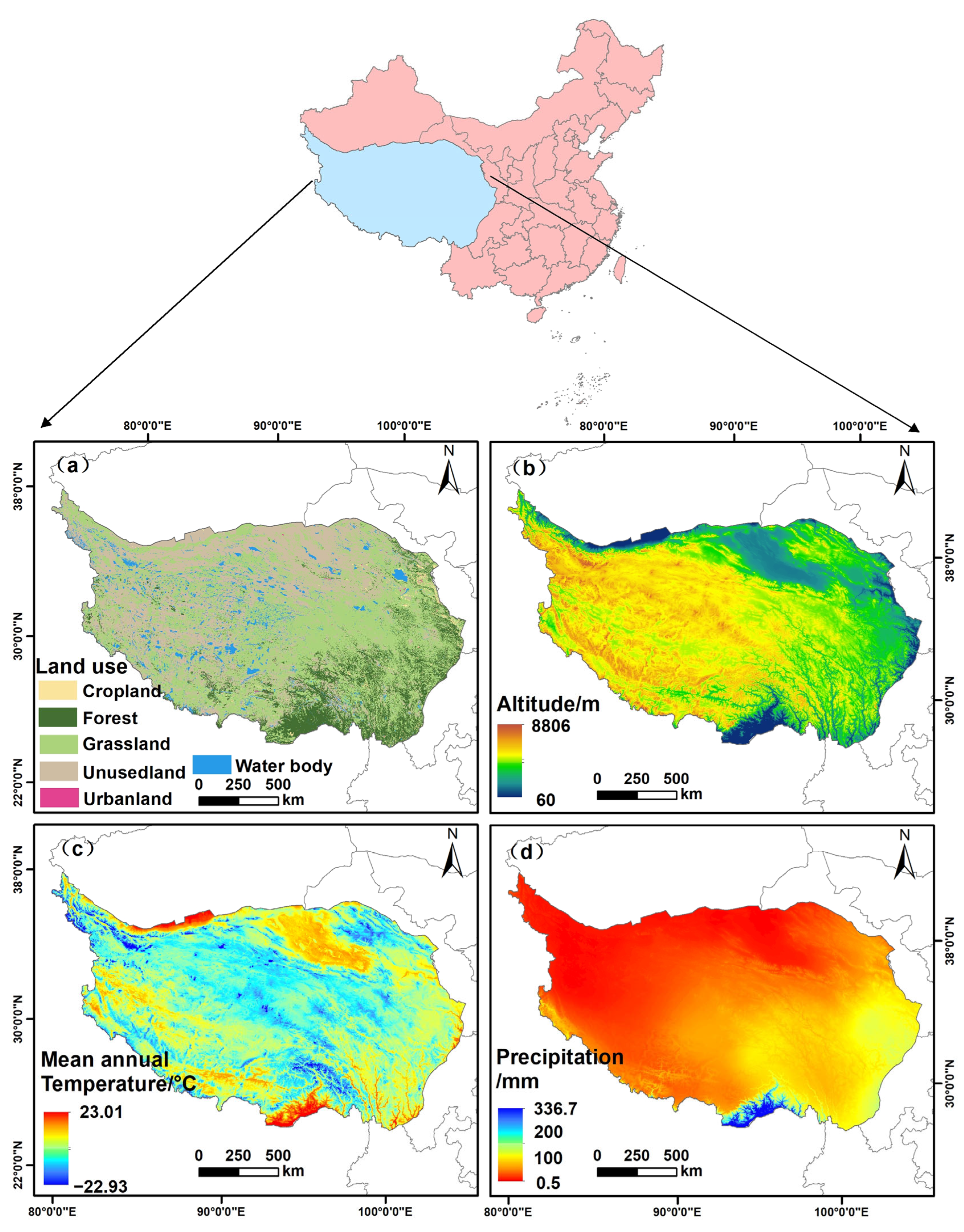

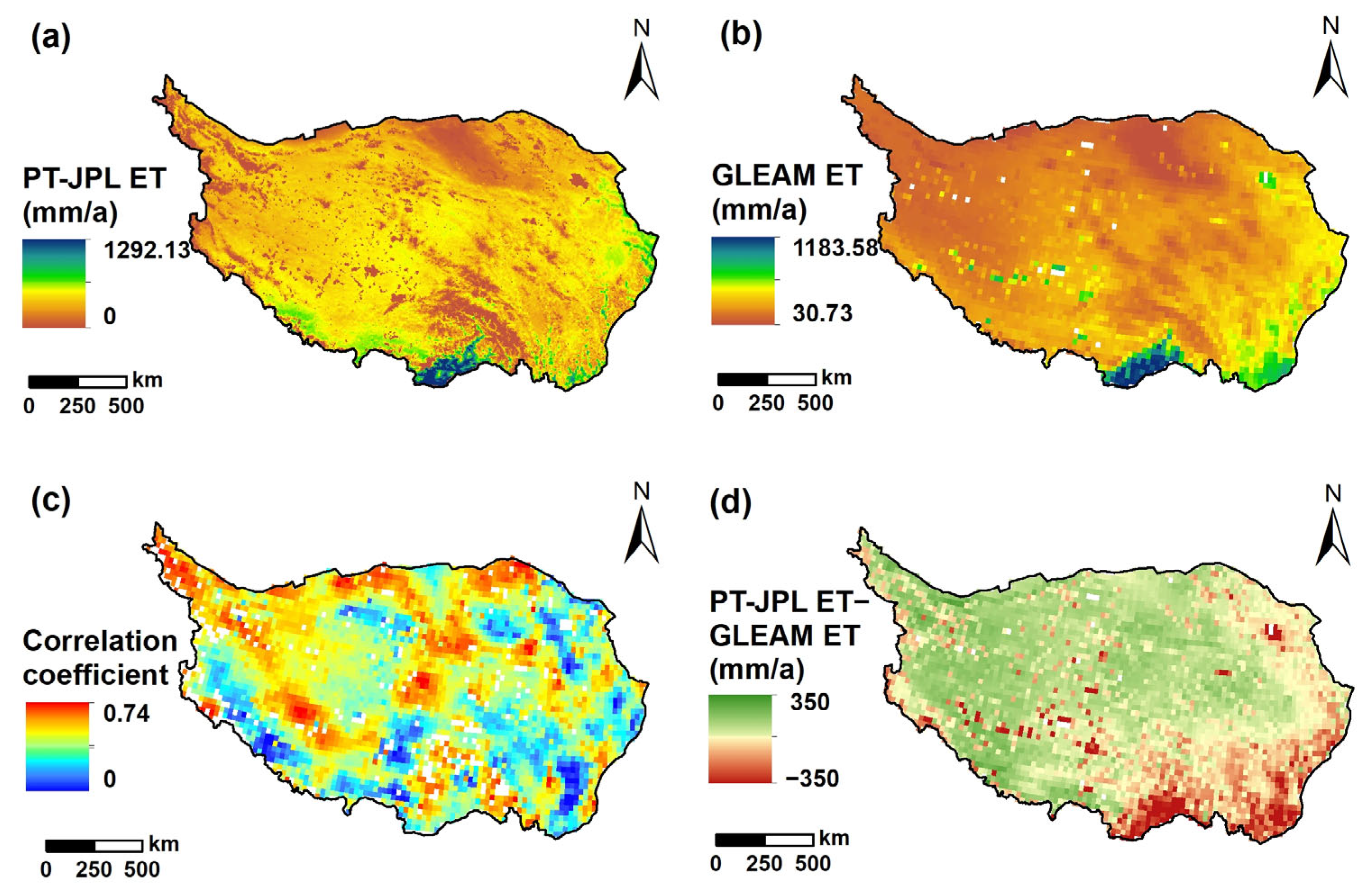
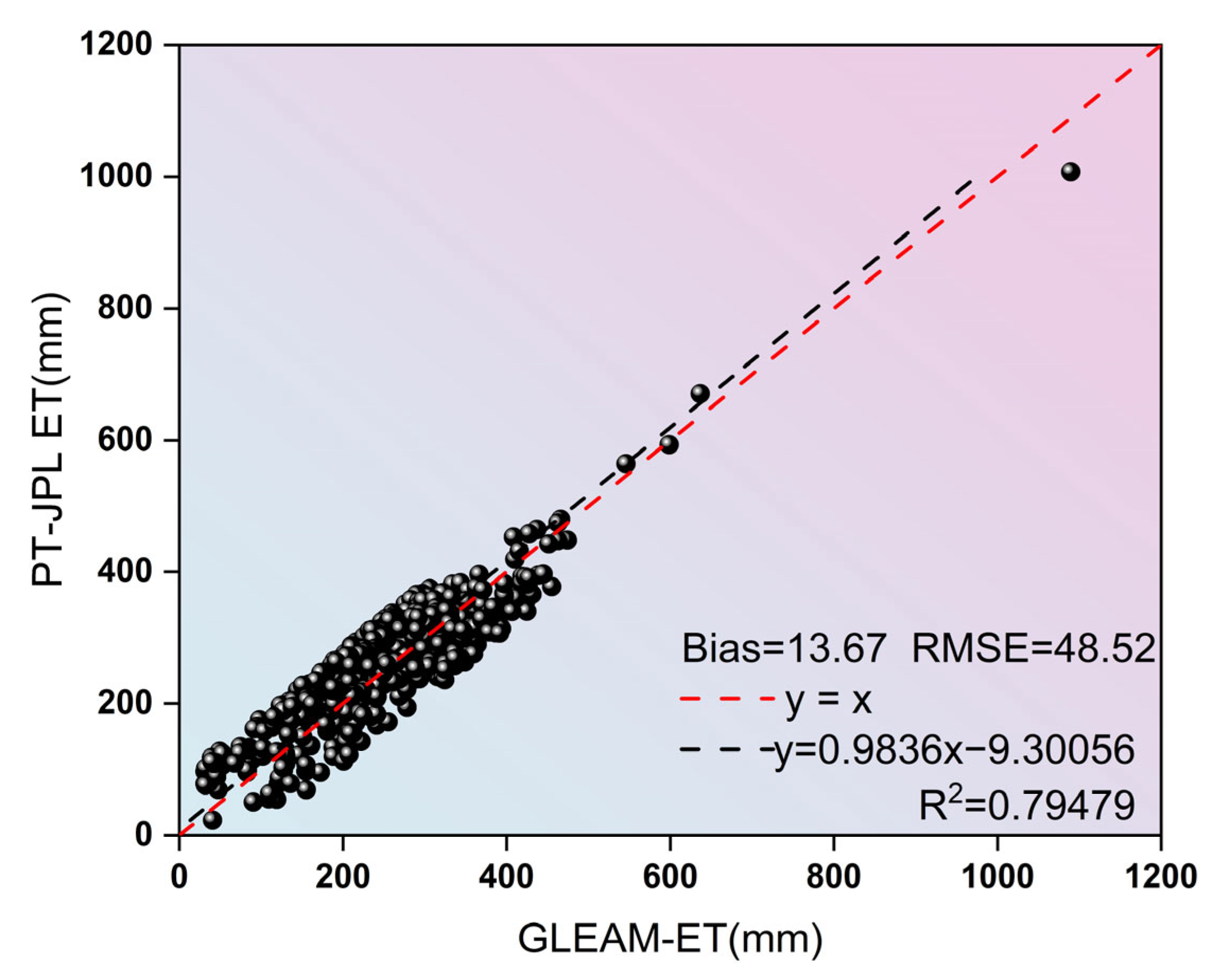
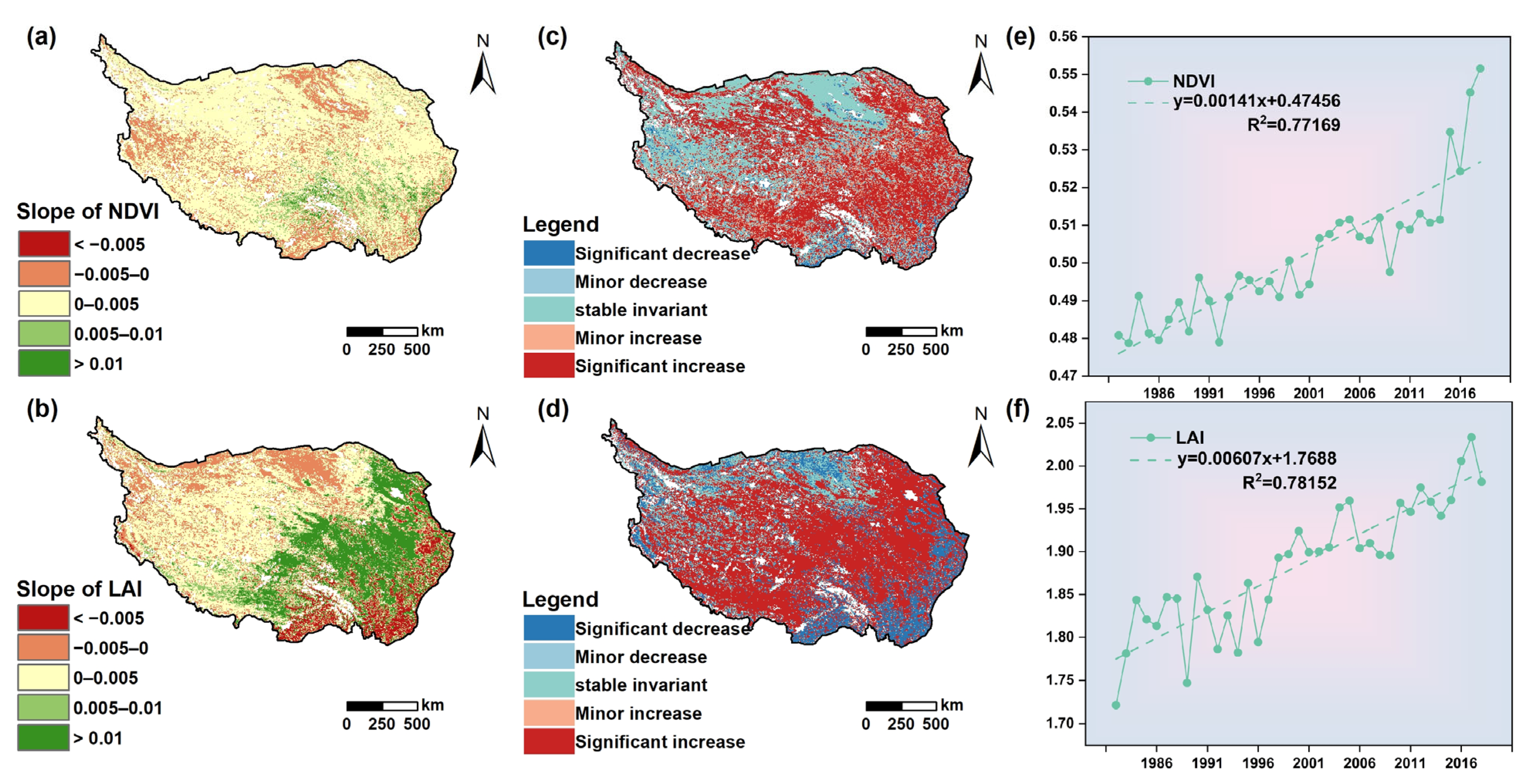
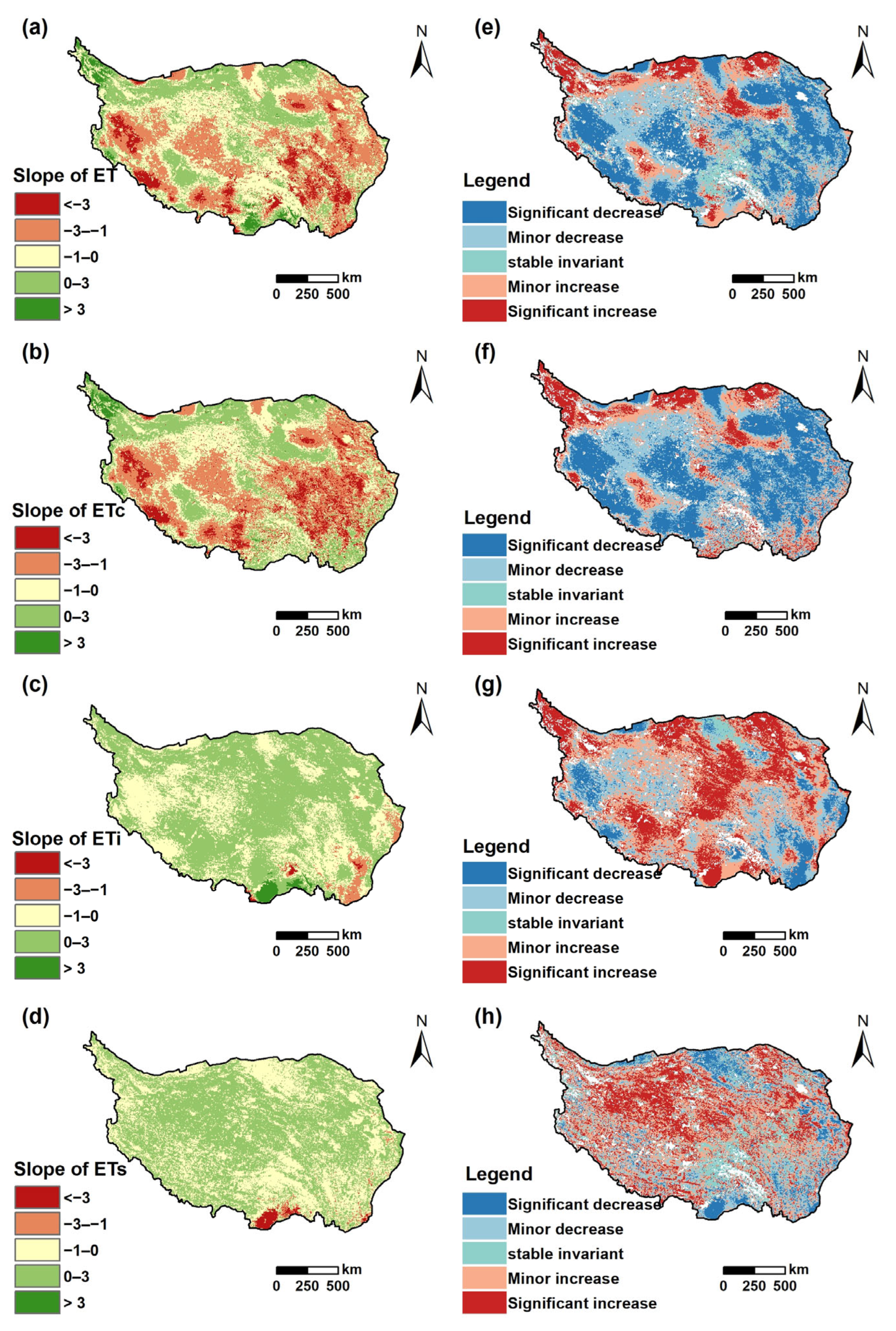

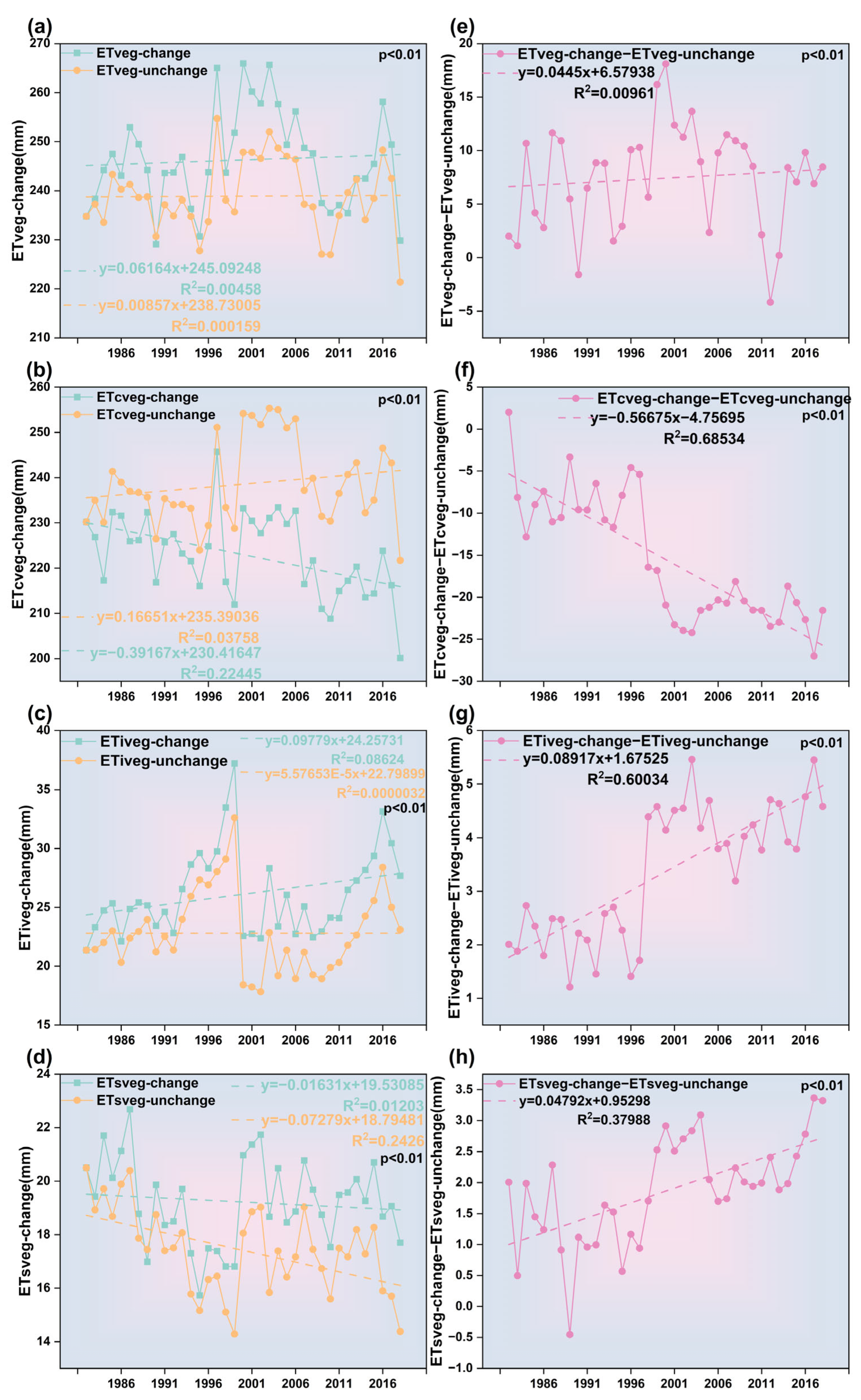
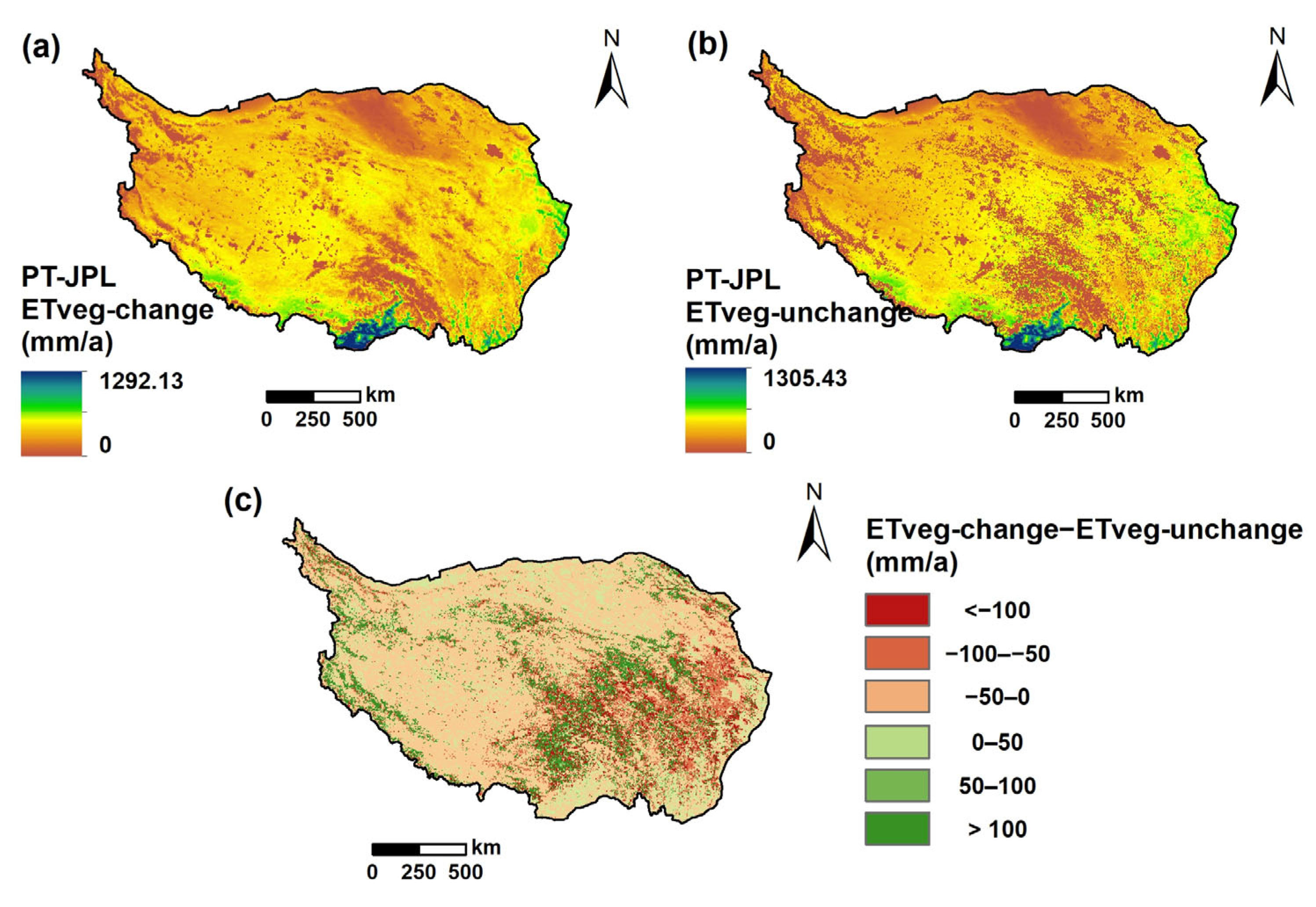

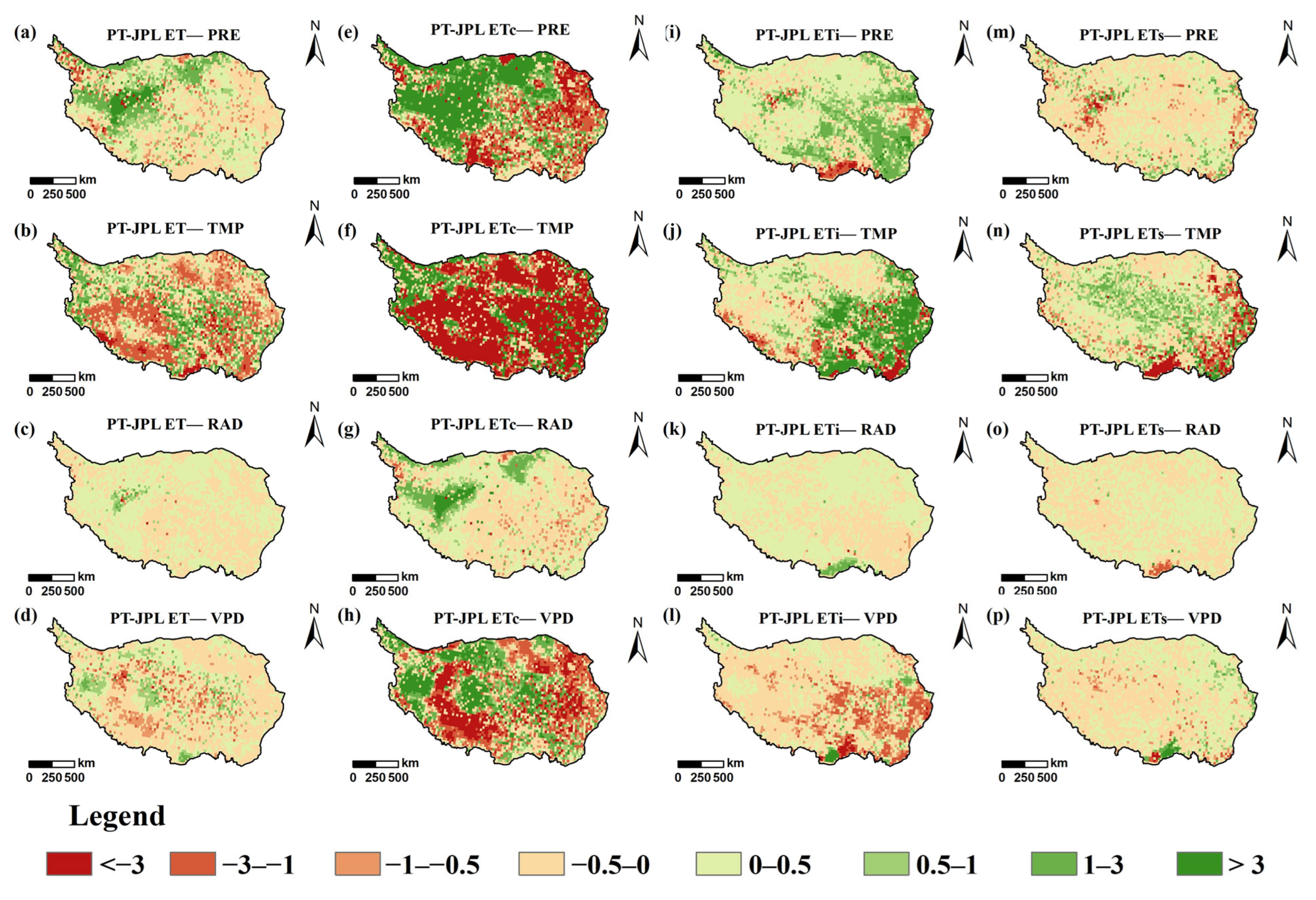
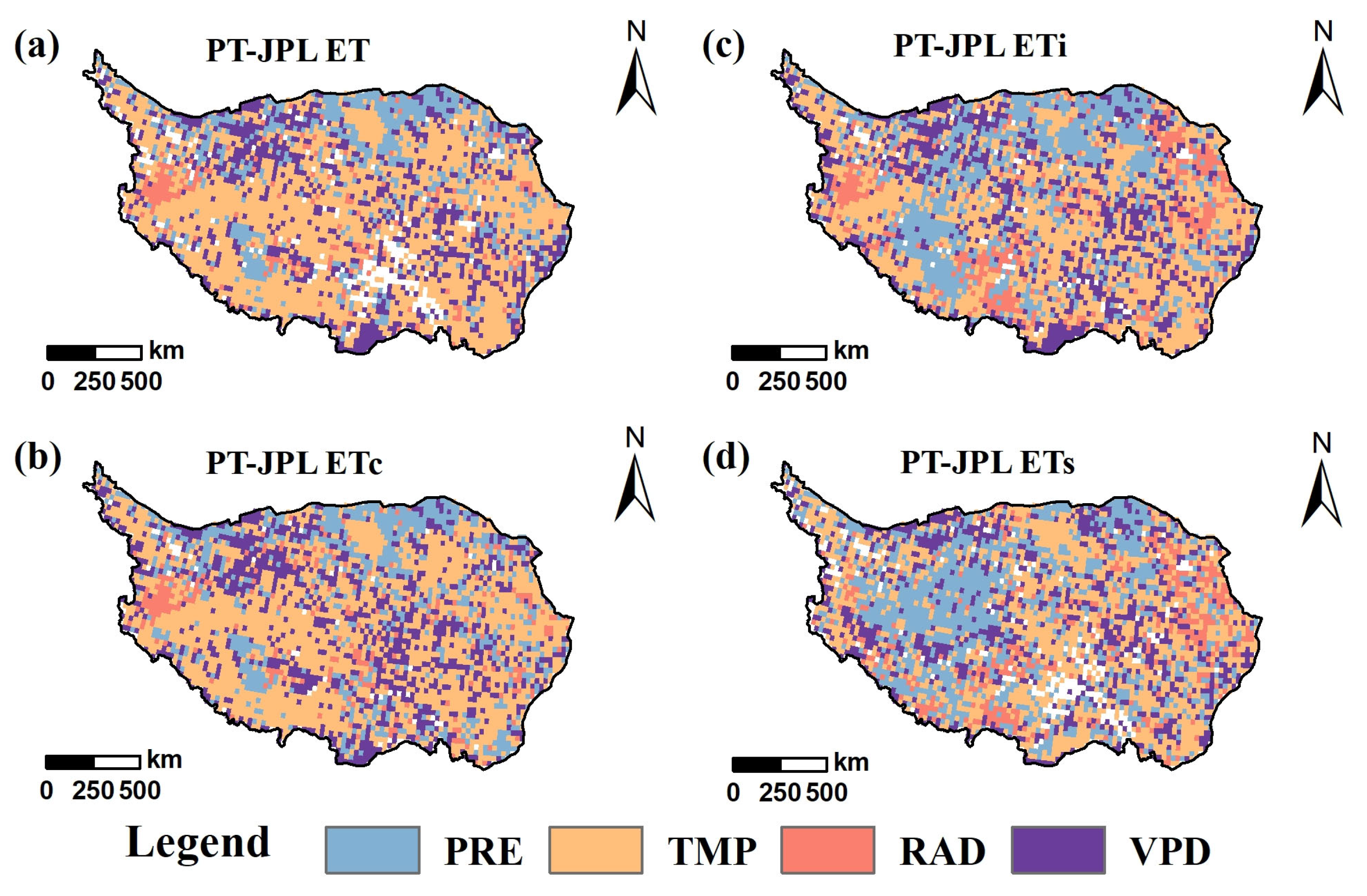
| Symbol | Description | Function/Formula | Data Source |
|---|---|---|---|
| Surface wetness fraction | CMFD RH | ||
| Green canopy fraction | MODIS NDVI | ||
| Temperature constraint | CMFD Temperature | ||
| Moisture constraint | MODIS LAI | ||
| Soil moisture constraint | CMFD RH, VPD | ||
| Fraction of absorbed PAR | MODIS LAI | ||
| Fraction of intercepted PAR | MODIS LAI |
Disclaimer/Publisher’s Note: The statements, opinions and data contained in all publications are solely those of the individual author(s) and contributor(s) and not of MDPI and/or the editor(s). MDPI and/or the editor(s) disclaim responsibility for any injury to people or property resulting from any ideas, methods, instructions or products referred to in the content. |
© 2025 by the authors. Licensee MDPI, Basel, Switzerland. This article is an open access article distributed under the terms and conditions of the Creative Commons Attribution (CC BY) license (https://creativecommons.org/licenses/by/4.0/).
Share and Cite
Han, P.; Ren, H.; Zhao, Y.; Zhao, N.; Wang, Z.; Wang, Z.; Liu, Y.; Wang, Z. Quantifying the Impact of Vegetation Greening on Evapotranspiration and Its Components on the Tibetan Plateau. Remote Sens. 2025, 17, 1658. https://doi.org/10.3390/rs17101658
Han P, Ren H, Zhao Y, Zhao N, Wang Z, Wang Z, Liu Y, Wang Z. Quantifying the Impact of Vegetation Greening on Evapotranspiration and Its Components on the Tibetan Plateau. Remote Sensing. 2025; 17(10):1658. https://doi.org/10.3390/rs17101658
Chicago/Turabian StyleHan, Peidong, Hanyu Ren, Yinghan Zhao, Na Zhao, Zhaoqi Wang, Zhipeng Wang, Yangyang Liu, and Zhenqian Wang. 2025. "Quantifying the Impact of Vegetation Greening on Evapotranspiration and Its Components on the Tibetan Plateau" Remote Sensing 17, no. 10: 1658. https://doi.org/10.3390/rs17101658
APA StyleHan, P., Ren, H., Zhao, Y., Zhao, N., Wang, Z., Wang, Z., Liu, Y., & Wang, Z. (2025). Quantifying the Impact of Vegetation Greening on Evapotranspiration and Its Components on the Tibetan Plateau. Remote Sensing, 17(10), 1658. https://doi.org/10.3390/rs17101658







